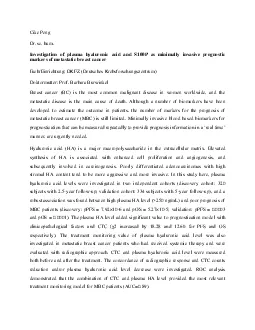

Cike PengDr schummarkers of metastatic breast cancerFachEinrichtung DKFZ Deutsches KrebsforschungszentrumDoktormutter Prof Barbara BurwinkelBreast cancer BC is the most common malignant disease in wo ID: 866346
Download Pdf The PPT/PDF document "Investigation of plasma hyaluronic acid ..." is the property of its rightful owner. Permission is granted to download and print the materials on this web site for personal, non-commercial use only, and to display it on your personal computer provided you do not modify the materials and that you retain all copyright notices contained in the materials. By downloading content from our website, you accept the terms of this agreement.
1 Cike Peng Dr. sc . h um . Investig
Cike Peng Dr. sc . h um . Investigation of plasma hyaluronic acid and S100P as minimally invasive prognostic markers of metastatic breast cancer Fach/Einrichtung: DKFZ (Deutsches Krebsforschungszentrum) Doktormutter: Prof. Barbara Burwinkel Breast cancer (BC) is the most common malignant disease in women worldwide, and the metastatic disease is the main cause of death. Although a number of biomarkers have been developed to estimate the outcome in patients, the number of markers for the prognosis of metasta tic breast cancer (MBC) is still limited. Minimally invasive blood based biomarkers for prognostication that can be measured repeatedly to provide prognosis information in a âreal timeâ manner, are urgently needed. Hyaluronic acid (HA) is a major macropoly saccharide in the extracellular matrix. Elevated synthesis of HA is associated with enhanced cell proliferation and angiogenesis, and subsequently involved in carcinogenesis. Poorly differentiated adenocarcinomas with high stromal HA content tend to be mor e aggressive and more invasive. In this study here, plasma hyaluronic acid levels were investigated in two independent cohorts (discovery cohort: 320 subjects with 2.5 - year follow - up; validation cohort: 334 subjects with 5 - year follow - up), and a robust ass ociation was found between high plasma HA level �(250 ng/mL) and poor prognosis of MBC patients (discovery: pPFS = 7.92×10 - 6 and pOS = 5.27×10 - 5; validation: pPFS = 0.0003 and pOS = 0.0001). The plasma HA level added significant value to prognostication mo del with clinicopathological factors and CTC (Ï2 increased by 18.28 and 12.60 for PFS and OS respectively). The treatment monitoring value of plasma hyaluronic acid level was also investigated in metastatic breast cancer patients who had received systemic therapy and were evaluated with radiographic approach. CTC and plasma hyaluronic acid level were measured both before and after the treatment. The concordance of radiographic response and CTC counts reduction and/or plasma hyaluronic acid level decrease we re investigated. ROC analysis demonstrated that the combination of CTC and plasma HA level provided the most rel
2 evant treatment monitoring model for MB
evant treatment monitoring model for MBC patients (AUC=0.89). S100P is a member of S100 family and has been proved to be associated with metasta sis establishment. The over - expression of S100P at tumor site has been reported in a number of solid tumors, including breast cancer. It has also been showed that breast cancer patients with overexpressed S100P in tumor tissue had shorter survival time co mpared to their counterpart. Although S100P is located in the cytoplasm and cell nuclear, it can also be secreted into the extracellular matrix in an autocrine and paracrine approach. Plasma S100P level was investigated in 381 subjects with up to 3.5 years follow up and found a robust association between high plasma S100P level (�7ng/mL) and poor prognosis of metastatic breast cancer (MBC) patients (median progression free survival time: 5.0 months vs. 8.7 months, log â rank test p 0.0001; median overall su rvival time: 22.5 months vs. 31.6 months, log â rank test p 0.001). The plasma S100P level added additional prognostic relevance to the conventional prognostication model with clinicopathological factors and CTC. The plasma S100P level decreased significan tly after treatment, while the reduction correlated with the radiographic response of the MBC patients. This finding indicated its value to CTC enumeration in dynamic evaluation of treatment outcome. Overall, we have discovered prognostic value of plasma h yaluronic acid level and plasma S100P level in metastatic breast cancer patients. The prognostic efficiency of the two novel circulating tumor markers is independent from clinicopathological factors and circulating tumor cells. The dynamics of plasma hyalu ronic acid and S100P level also displayed treatment monitoring efficiency as CTC counts. The combination of plasma hyaluronic acid level, plasma S100P level and CTC even provided the most efficient treatment monitoring information then any single marker ap proach. Considering the complexity of CTC enumeration, our study suggested plasma hyaluronic acid and S100P level as the cost â effective prognostic markers of MBC patients, which are complementary to the current CTC enumeration approach.